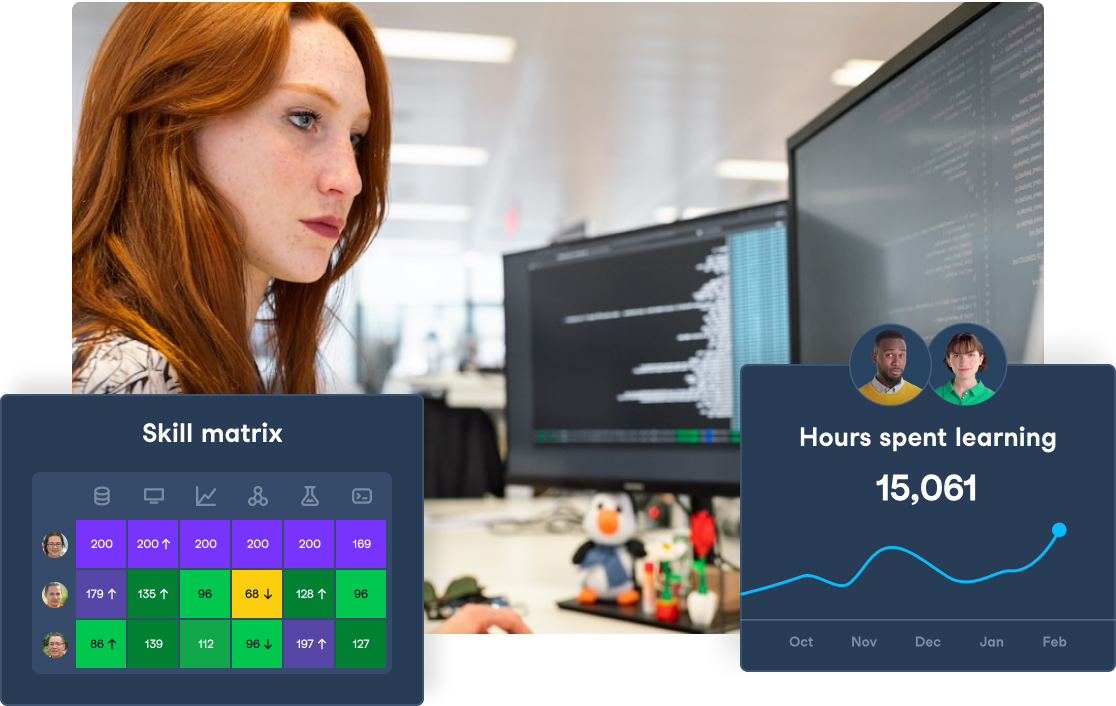Let's say you're a hiring manager of a large company writing a data analyst job description for a role you're trying to fill on your team. Where do you start? Now, let's say you're a job seeker looking to land a data analyst job. What skills should you highlight on your resume? How do you know what the market is looking for? We've got you covered!
In this article, we'll discuss the nuts and bolts of what a data analyst job description looks like. We'll go over the different analyst types, a data analyst's responsibilities, industry differences, the qualifications and skills required to do the job, and the structure of a good data job description.
For similar roles, check out our guides on data scientist job descriptions and data engineer job descriptions. For those looking to develop their internal data teams, check out our webinar on Building Effective Data Teams.
Empower Your Team with Data Analysis Expertise
Enable data-driven decision-making with DataCamp for Business. Comprehensive courses, assignments, and performance tracking tailored for your team of 2 or more.

The Different Types of Analysts
A data analyst plays a crucial role in any organization by collecting, organizing, and analyzing large datasets to inform strategic business decisions. However, the analytics field has become increasingly specialized and depending on the type of work you need help with, you may want to think about the type of analyst you hire.
- Data Analyst. A traditional data analyst builds reports and performs analyses to inform strategic business decisions. A strong foundation in statistics, SQL, and visualization concepts is important in this role.
- Business Analyst. A business analyst leverages data tools to improve internal business processes. In this role, a strong knowledge of SQL and project management tools is important.
- Business Intelligence Analyst. A business intelligence analyst also has a strong focus on improving the health of the business but shares a lot of similar functions with a data analyst. Again, a detailed knowledge of SQL, project management, and visualization tools is necessary for this role.
- Data Engineer. Data engineers focus on building the data infrastructure to collect, store, and transform data so that it's ready to analyze. A knowledge of data orchestration tools, like Airflow, and strong programming skills are helpful in this role.
- Analytics Engineer. The analytics engineer role is a hybrid between a data engineer and a data analyst. The engineer's role is to build data pipelines and perform analyses to drive informed business decisions. With the advent of tools like dbt, data modeling is easier than ever. A good handle of a data orchestration tool as well as strong knowledge of SQL are fundamental to this role.
- Data Scientist. A data scientist has a similar function to a data analyst; a data scientist prepares analyses that drive the business forward. However, a large component of this role relies on leveraging predictive analytics and forecasting methods. A deep knowledge of inferential statistics, machine learning, and programming are essential to succeed.
Outside of the analyst type, you'll also need to think about your own business model before writing the description. While a lot of data analyst skills are transferable and responsibilities will carry over from one job to the next, there may be differences based on the industry in which you operate (healthcare, government, fintech, etc.).
Data Analyst Responsibilities
Below, we’ve highlighted some of the key roles and responsibilities of a typical data analyst. Again, these will differ depending on your business, industry, and team structure.
Core Data Analyst Responsibilities
At its core, a data analyst's responsibilities rest on three pillars: automation, reporting, and data governance. Let’s look at each in more detail.
- Automation. A data analyst should often work to automate tasks requiring repetitive motions. Saved time at an individual level means more time to work on other projects. At a company level, this means less wasted money and the potential to build more revenue streams.
- Reporting. This area is the crux of a data analyst's job – analysis and visualization. Reporting encompasses everything from reporting on company key performance indicators (KPIs) to visualizing the insights and communicating them to an audience.
- Data governance. As the saying goes, "garbage in, garbage out." A data analyst can only do so much analysis on bad data before reports start breaking and the insights become flawed, leading to poor business decisions. An essential role of a data analyst is to identify and fix data quality issues. Other aspects of a data governance program include improving documentation, tagging and classifying data assets, and developing good metadata management practices.
Other Responsibilities
Other responsibilities that a data analyst may have include:
- Answering ad-hoc data questions;
- Providing enablement sessions for data users; and
- Removing tech debt (i.e. the stuff that doesn't add value and only clutters an analytics environment)
Differences Across Industries
Outside of core responsibilities, data analysts may develop specialization(s) based on the business industry in which they have worked or are working in. Developing business context has many advantages, including reducing the time it takes for a data analyst to ramp and digging deeper into relevant industry-specific topics. However, the intrinsic job requirements of a data analyst do not vary drastically from one sector to the other.
In some industries, such as finance or healthcare, a data analyst may be focused on more specific types of data, such as financial records or patient records. In marketing or e-commerce, a data analyst might be responsible for analyzing customer behavior and trends. In sales, a data analyst may be more interested in conversion rates between different stages of a sales funnel.
Data Analyst Qualifications
A data analyst will need a range of different skills, knowledge and education. You can find out how about how to become a data analyst in a separate article. Although experience can also play a big part in finding the right candidate, many roles will require some combination of the following:
Education
A typical prerequisite for a data analyst role is a Bachelor's degree in a quantitative field (computer science, mathematics, or economics). However, the ability to teach oneself using online resources has never been easier. As an example, DataCamp offers a fully integrated Data Analyst Certification online. It gives anyone wishing to transition into data analytics a chance to learn essential analytics skills from their home. For candidates with non-traditional backgrounds, experience, projects, portfolios, and online certifications are all great ways to assess a candidate's experience level in the field.
Knowledge and Tools
Getting certified is a great first step. However, it doesn't end there. A data analyst must also demonstrate that they can perform the job responsibilities required of a data analyst. How do you apply conditional formatting in a spreadsheet? What is the difference between a LEFT JOIN and a RIGHT JOIN in SQL? How is the line of best fit determined in a linear regression model? These are the data analyst interview questions you must be prepared to know. In this section, we look at what a data analyst's toolkit includes.
Statistics and Probability
A solid foundation of statistics and probability is a must to operate in an analytical role, particularly knowledge of the measures of center and spread, linear regression, non-linear regression, sampling distributions, hypothesis testing, etc.
Spreadsheet (Excel/Google Sheets)
While chatGPT may take over the world someday, a lot of work is still done in spreadsheets. As the ubiquitous tool of choice in the business world, developing a solid knowledge of Excel or Google Sheets can be useful. Check out our Spreadsheet Fundamentals skill track to become a spreadsheet pro.
SQL
SQL is the bread and butter of analytics. It's a language used to communicate with a database to retrieve data and perform analysis on top of it. Technical interviews consist primarily of one or multiple SQL questions. If you're looking for an introduction or a refresher, take a look at our Introduction to SQL Course.
Programming
For more advanced analysis, a scripting language may come in handy to fill the gaps of other analytics tools. Python and R are commonly used by data analysts to perform statistical analysis at scale. For Python, check out the Data Analyst with Python career track on DataCamp. For R, take a look at the Data Analyst with R career track.
Visualization Tools
If analyzing the data is important, communicating the insights is essential. A data analyst leverages any visualization tools available in the marketplace, such as Microsoft Power BI, Tableau, Looker, etc., though analysts may have varying degrees of familiarity.
Engineering Tools
Data build tool (dbt) – while analytics engineering is a relatively new concept, dbt has taken the analytics world by storm. dbt is a tool built on the concept of ELT (Extract-Load-Transform) as opposed to ETL (Extract-Transform-Load), which facilitates the data transformation process based on data already loaded into a data warehouse. L
Git/Github – version control tool used to keep logs of changes made to sql scripts, data models, workbooks, etc. All the info is centralized in repositories on Github, the platform that supports Git, and allows for better inter-collaboration on an analytics team.
Soft Skills
While building strong quantitative skills is important, it comes together by developing the following skills, which are essential traits to look for in a data analyst.
- Cross-functional collaboration
- Project management
- Working on ambiguous/complex problems
- Attention to detail
Data Analyst Job Description Template
Below is a job description template for a data analyst role. You may use any of the text as a starting point, but be sure to personalize as much as possible based on your company needs, the business industry, the specific projects you need help with, etc. Personalization is key to source better, more informed candidates.
Job Title: Data Analyst
Location: [City, State] / [Fully Remote] / [Hybrid]
Job Description:
We are seeking a highly skilled and detail-oriented Data Analyst to join our team. In this role, you will be responsible for collecting, organizing, and analyzing large datasets to provide insights and support decision-making within the organization. You will also be responsible for creating reports and visualizations to communicate your findings to various stakeholders.
Responsibilities:
- Collect, clean, and organize data from various sources
- Perform statistical analysis and develop reports and visualizations to communicate findings
- Work with cross-functional teams to identify trends and patterns in data
- Create dashboards and automated reports to monitor key performance indicators
- Continuously improve processes and systems for data collection, analysis, and reporting
Qualifications:
- [optional] Bachelor's degree in a related field (e.g., Computer Science, Mathematics, Statistics)
- 2+ years of experience as a data analyst or related role. If you don't have 2+ years of experience in the field, please share related projects you have worked on in the past.
- Strong knowledge of SQL
- data visualization tools (e.g., Tableau, Excel, Looker, Google Sheets)
- Experience with statistical analysis software (e.g., R, Python) is a plus
- Excellent problem-solving and communication skills
- Ability to work independently and manage multiple projects at once
Conclusion
Save, click, and post. Congrats, you've now shared a perfectly articulated job description. Now begins the hard part of interviewing the right candidates to find a good match for the open position. Don't forget to check out DataCamp's Recruit platform to connect with top talent. For job seekers, you can find a selection of open positions on DataCamp's Data Jobs platform.
Want a better understanding of data analysis and what it entails? See our 'what is data analysis' guide.
Training 2 or more people? Check out our Business solutions
Get your team access to the full DataCamp library, with centralized reporting, assignments, projects and more


Data analyst by day, storyteller by night. I love using my knowledge to bridge the data literacy gap and help newcomers transition into the field. My philosophy is to learn every day, if only for 5 minutes!
